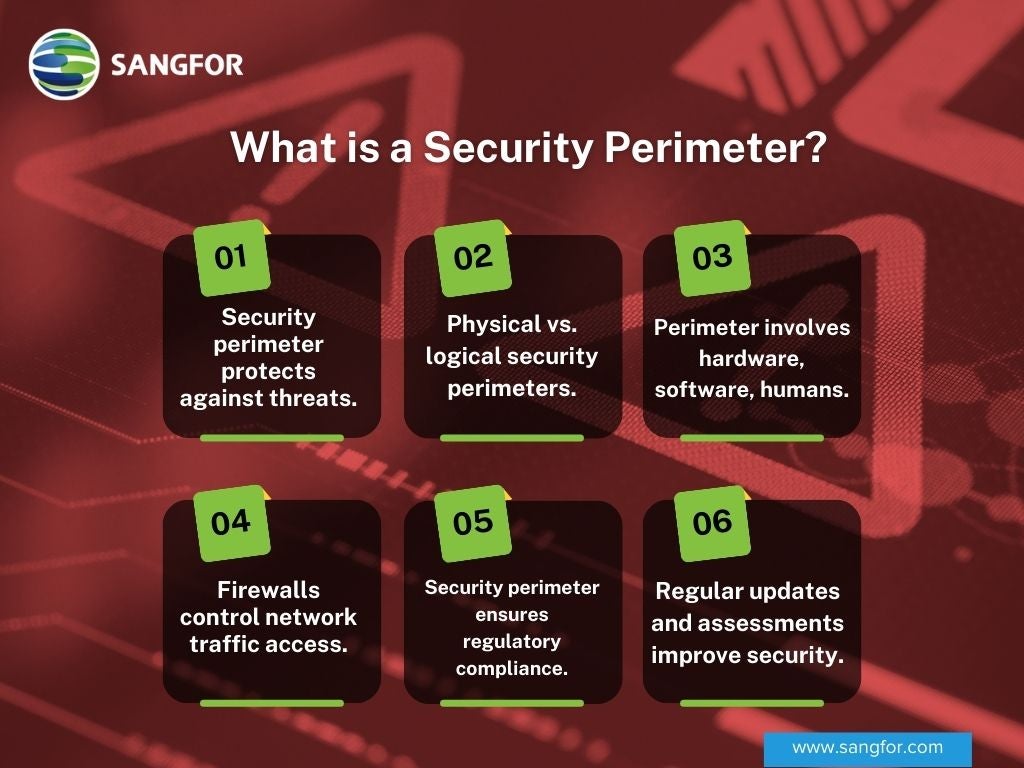A security perimeter is a critical component of cyber security. It protects networks, applications, and data against unwanted access and cyber threats.

What is a security perimeter?
The boundary that divides a network or system from the outside world, including the internet, is called a security perimeter. A security perimeter can be physical or logical. A physical security perimeter refers to impediments such as fences, walls, and gates that block access physically. Logical security perimeters use security protocols, access controls, and firewalls to control access to the network and its resources.
Moreover, a logical security perimeter usually includes hardware, software, and human elements. Hardware perimeter security involves network devices such as firewalls, intrusion detection systems, routers, and switches. Software perimeter security is designed to protect networks. It includes access control software, authentication, encryption technologies, and antivirus products.
Additionally, human elements can include elements such as passwords, user IDs, physical entry cards, video surveillance systems, guards, and alarm systems. Most companies use multiple hardware and software products in conjunction with each other to create a strong defense system.
Any organization's cyber security strategy should employ a security perimeter as it provides a first line of defense against external threats. As such, it helps to ensure information assets' confidentiality, integrity, and availability.

How does a security perimeter work - What are the essential elements?
Any effective security perimeter will have some or all of these essential elements:
- Security Protocols: Secure Sockets Layer (SSL) and Transport Layer Security (TLS) encrypt data as it travels across the network. The encrypted data ensures its security from malicious actors.
- Access Controls: Access controls including effective passwords, biometric authentication, and smart cards give access to authorized users only. Other access controls such as RBAC can also be used.
- Firewalls:Firewalls are used to monitor and control network traffic. They will allow only authorized traffic to pass through while blocking unauthorized traffic. They can be either hardware or software-based. They can be configured to block certain types of traffic. For example, they can block certain ports or protocols.
Check this video to learn more about The Next Evolution of Sangfor's Firewall Platform:
Why is security perimeter important?
Apart from being the first line of protection against outside threats, a security perimeter is essential to have in place because:
Regulatory compliance
Organizations can protect the confidentiality, integrity, and availability of personal and sensitive information. As such, they can comply with regulatory requirements such as the General Data Protection Regulation (GDPR).
Risk reduction
By preventing unauthorized access to vital infrastructure and systems, enterprises can reduce the risk of downtime and data loss.
Reputation and financial loss
Organizations that have been affected by data breaches normally face hefty fines from regulators as well as reputation backlash from users.
In general, the security perimeter is an important part of every organization's cyber security strategy. It provides the necessary controls to protect against external threats and adhere to regulations. It also helps ensure the confidentiality, integrity, and availability of information assets.
How can you improve perimeter cyber security?
Some steps organizations can take to enhance their perimeter security:
- Keep software and hardware up-to-date. Update software and hardware devices such as firewalls, routers, and switches often. Ensure that the latest security patches are in use to prevent the exploitation of potential vulnerabilities.
- Implement mult-ifactor authentication. Require users to provide more than one form of authentication can enhance security.
- Use encryption technologies. Enable encryption technologies such as Secure Sockets Layer (SSL) and Transport Layer Security (TLS). These can help protect sensitive data in transit over the network.
- Conduct regular security assessments. Regular security assessments, like penetration testing, can help identify weaknesses in the security perimeter. Identification of weaknesses can allow organizations to take corrective actions.
- Educate employees on cyber security best practices. Educate employees on cyber security best practices. Education should include strong passwords, avoiding suspicious emails, and using company-approved devices and software.
Final thoughts
As the first line of defense from external threats, a security perimeter is a must for any organization's cyber security strategy. The security perimeter's design, implementation, and management are critical to its effectiveness. Cyber security professionals must ensure that their security perimeters are appropriately designed and configured. Additionally, security perimeters must be regularly tested and updated to keep up with evolving threats and compliance requirements.
Organizations must take a holistic approach to cyber security. Such an approach will include implementing best security practices across all organization areas. Organizations can improve their cyber security by taking a comprehensive approach. This will help them to establish strong security perimeters and maintain a secure posture. This will prevent cyber threats and keep their data safe.
At Sangfor, we understand the importance of cyber security and the potential damage that malware can cause. That's why we offer comprehensive securitysolutions and services to help you protect your organization from such threats.Contact us today to learn more about our cybersecurity solutions and how we can help safeguard your business from malicious attacks. Click here to learn more about our service offerings.
Frequently Asked Questions
The purpose of a security perimeter is to protect networks and systems from unauthorized access and external cyber threats by establishing boundaries between trusted internal networks and untrusted external networks.
A physical security perimeter involves physical barriers such as walls and gates, while a logical perimeter uses software-based controls like firewalls and access protocols to prevent unauthorized access.
A security perimeter helps organizations comply with regulations like GDPR by protecting sensitive data and ensuring its confidentiality, integrity, and availability.
Key elements include security protocols (SSL/TLS), access controls (biometrics, smart cards), and firewalls, which work together to monitor and control network traffic.
Organizations can enhance perimeter security by keeping systems updated, implementing multi-factor authentication, using encryption technologies, and conducting regular security assessments.
Without a security perimeter, organizations are vulnerable to data breaches, loss of sensitive information, and compliance violations, leading to financial and reputational damage.





